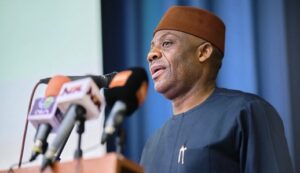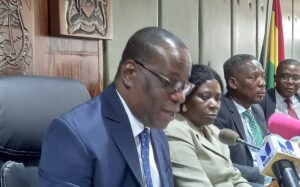
Part 1: The Beginning
In the heart of Nairobi, Kenya, political strategist Amani Kilonzo sat in her modest office overlooking the bustling streets. She had built a reputation as a brilliant mind in political strategy, known for her ability to navigate complex political landscapes. Her phone buzzed with a message from one of her clients, a promising young politician named Juma Odinga.
Juma was running for a parliamentary seat in his hometown of Kisumu. He was passionate about change and driven by a desire to improve the lives of his constituents. However, his campaign faced numerous challenges, from managing diverse voter expectations to navigating political rivalries.
“Amani, I need your guidance,” Juma’s message read. “Can we meet tomorrow?”
Amani replied with a swift “Of course,” knowing that their upcoming discussion would be crucial in shaping Juma’s campaign strategy.
Part 2: The Consultation
The next day, Amani traveled to Kisumu, a city on the shores of Lake Victoria. The meeting was held in a small, private conference room. Juma welcomed her warmly, his face etched with a mix of hope and concern.
“Amani, I’m struggling to connect with the older generation,” Juma began. “They’re skeptical of my youth and experience.”
Amani nodded thoughtfully. “It’s essential to understand their concerns and address them directly. Have you considered organizing community forums to listen to their issues and share your plans?”
Juma’s eyes brightened. “I hadn’t thought of that. It sounds like a good way to build trust.”
Amani continued, “Also, leverage your youth by showcasing your energy and fresh ideas. Balance this with respect for their wisdom and experience. Highlight how your approach can bring positive change without dismissing their contributions.”
Part 3: The Strategy
In the days that followed, Amani worked closely with Juma’s campaign team. They devised a multi-faceted strategy that included community forums, social media engagement, and alliances with influential local figures. The aim was to present Juma as a bridge between generations, someone who valued the past but was focused on a better future.
One of the pivotal moments came during a large community forum in Kisumu. Juma stood before a diverse crowd, from elderly farmers to young entrepreneurs. He spoke passionately about his vision for the region, emphasizing infrastructure development, education, and healthcare improvements. He also listened attentively to their concerns, acknowledging the wisdom and experience of the older generation.
Amani watched from the sidelines, noting the positive reactions. She knew that the real work lay in the follow-up, ensuring that Juma’s promises were not just words but translated into actionable plans.
Part 4: The Challenges
As the campaign progressed, Juma faced a formidable opponent, Mwangi Njoroge, an established politician with deep roots in the community. Mwangi’s campaign was well-funded, and he had the advantage of incumbency. Amani knew that they needed a strategy to counter Mwangi’s influence without engaging in negative politics.
“We need to focus on what sets you apart,” Amani advised. “Highlight your new ideas and your genuine commitment to the community. Show that you are not just another politician but a true advocate for change.”
Juma embraced this approach, using every opportunity to differentiate himself. He visited schools, hospitals, and markets, engaging directly with people and discussing how his policies would impact their lives positively. He also utilized social media to reach younger voters, creating a series of videos that showcased his interactions with the community and his vision for the future.
Part 5: The Turning Point
One of the critical moments of the campaign came during a televised debate between Juma and Mwangi. The debate was held in Nairobi and broadcast nationwide. Amani had prepared Juma meticulously, focusing on key points and potential counterarguments.
During the debate, Mwangi tried to undermine Juma’s credibility by questioning his experience. However, Juma remained composed and responded with a blend of respect and assertiveness. He acknowledged Mwangi’s years of service but emphasized the need for new perspectives and innovative solutions.
“What our community needs now are fresh ideas and a leader who can connect with all generations,” Juma stated. “I bring not only a vision for the future but also a deep respect for our traditions and values.”
The audience response was overwhelmingly positive. Amani watched with pride as Juma held his ground, his confidence and authenticity shining through.
Part 6: The Outcome
As election day approached, the atmosphere was charged with anticipation. Amani and Juma’s team worked tirelessly to ensure that their message reached every corner of the constituency. They organized final rallies, distributed flyers, and maintained a strong social media presence.
On the day of the election, the people of Kisumu turned out in large numbers to cast their votes. The results were announced late in the evening, and the tension was palpable. When Juma’s victory was declared, the celebration was euphoric. He had won not just by a slim margin but with a significant lead, a testament to the effectiveness of his campaign strategy and his connection with the voters.
Amani reflected on the journey, the challenges they had faced, and the strategies they had implemented. She knew that Juma’s victory was not just a win for him but for the community that had placed its trust in him.
Part 7: The Aftermath
In the weeks following the election, Juma took his oath of office and began his work as a member of parliament. True to his word, he prioritized the issues he had campaigned on. He initiated infrastructure projects, advocated for educational reforms, and worked to improve healthcare services.
Amani continued to support him, offering strategic advice and helping him navigate the complexities of political decision-making. She knew that maintaining the trust of the constituents required consistent effort and transparency.
Juma’s success also inspired other young leaders across Kenya and beyond. They saw in him a model of how to balance innovation with respect for tradition, how to engage with the community genuinely, and how to navigate political challenges with integrity.
Conclusion
The story of Juma Odinga and Amani Kilonzo is a testament to the power of strategic decision-making in politics. It highlights the importance of understanding and addressing the concerns of different demographics, the value of genuine community engagement, and the need for innovative yet respectful approaches to leadership.
Their journey, set against the vibrant backdrop of Kisumu and Nairobi, reflects the dynamic and evolving nature of African politics. It shows that with the right strategies and a commitment to positive change, even the most challenging political landscapes can be navigated successfully.








